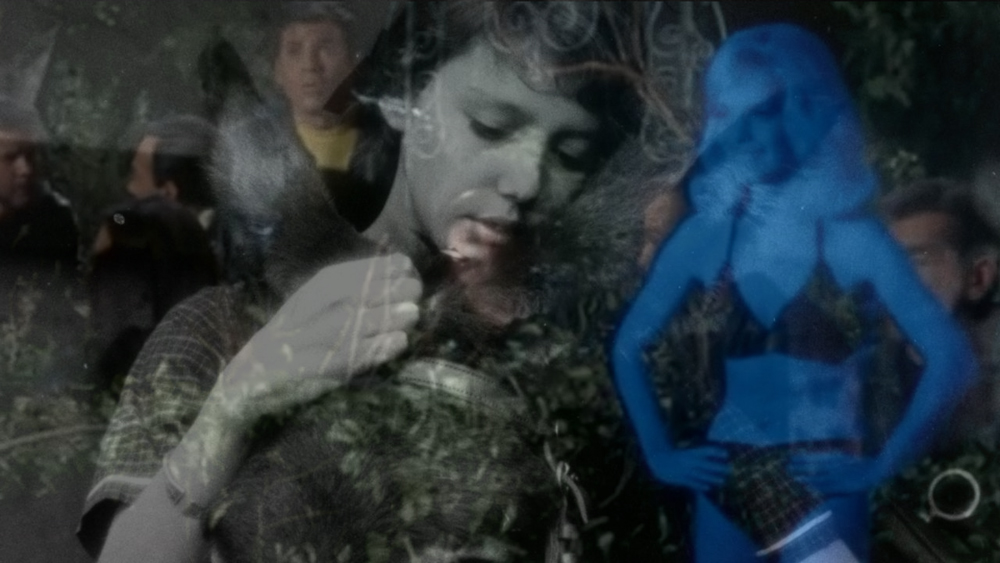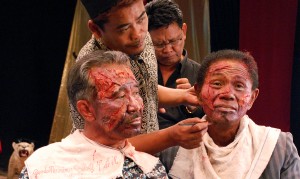
I was delighted to see that in my assigned match-up, a venerated art house classic would be squaring up with cheap, insipid trash. It’s the sort of juxtaposition I live for. It’s the sort of exploration of diversity—one year, two wildly different films—that drives the Tournament of Films. In one corner, a highly spiritual film which seems to contain the breadth of human experience; in the other, a French flick about a donkey.
The Ghost in the Invisible Bikini marks the last entry in the once-popular series of “beach party” films released by American International Pictures. First appearing in 1963 with the massively successful Beach Party, these films embraced teenage trends and interests, such as surfing, rock music, and motorcycle racing, and combined them with lighthearted romance and a bikini-clad cast to successfully capitalize on a teenaged demographic. In this way, they managed to “simultaneously chronicle and be a part of a particularly vibrant moment in American popular culture,” according to John M. Miller of Turner Classic Movies. On all these points, The Ghost in the Invisible Bikini delivers, with one exception: no beach on which to party. Instead, our fun-loving teens congregate at a pool on the grounds of an old haunted mansion, making this film—as if you couldn’t guess—a campy horror parody.
Bad news: put in practice, The Ghost in the Invisible Bikini does not live up to this concept’s promising brilliance, presenting instead an overstuffed premise that is, may I say, impossible to summarize: Boris Karloff plays Hiram Stokely, carnival mogul and owner of the mansion, who learns from the ghost of his long-dead girlfriend Cecily (Susan Hart, the titular ghost) that he’s died. She informs him that to enter Heaven, where he will enjoy eternal youth, he must perform one good deed within a day’s time. He gazes into a crystal ball (establishing the film’s frame) and sees Reginald Ripper (Basil Rathbone), his lawyer, planning to claim the estate by scaring away or killing the rightful heirs. The heirs: teens Chuck (Tommy Kirk) and Lili (Deborah Walley), whose relationship to Stokely is never established, and Aunt Myrtle (Patsy Kelly), who has invited her nephew Bobby (Aron Kincaid), who has extended the invitation to all his teenaged friends—cue pool party. Meanwhile, Ripper’s cigar-chomping goon, J. Sinister Hulk (Jesse White), has summoned hitmen Yolanda (Bobbi Shaw) and gallingly racist Native American caricature Chicken Feather (Benny Rubin). Pursuing the latter two is motorcycle gang the Rat Pack, led by Eric Von Zipper (Harvey Lembeck), who fell in love with Yolanda when he rescued her from a pond. Stokely decides that his good deed will be ensuring that his “heirs” receive their inheritance; to this end, he dispatches Cecily to the mansion. Whew! (Also, Nancy Sinatra sings a surf rock tune called “Geronimo” in possibly the film’s most redeeming moment.)
The issue is that The Ghost in the Invisible Bikini lacks a central narrative, or even a protagonist. Instead of a plot, we’re given a sequence of gags, chase scenes, and impromptu musical numbers until all the characters finally wind up in the same room and find the money. For this reason, it doesn’t reward close attention, and it seems that director Don Weis and writers Louis M. Heyward and Elwood Ullman simply have no interest in establishing a coherent progression of action. It’s as if this lack of structure is the product of a virtuous dedication to pure fluff, as if narrative tension and audience investment spoil the spirit of escapism.
It’s hard to believe, then, that the film’s first cut was so chaotic, the producers demanded a semblance of structure be imposed, leading to the creation of the framing device/Boris Karloff plotline. It begs the question: just how bad could it have been that this final product’s an improvement? Stokely’s presence is limited to expository observations and one-liners, while Cecily, chroma-keyed over the original footage, pauses time to preempt jokes or comment directly on the unfolding hijinks. In other words, Cecily’s presence is intrusive, and Hiram’s is a woeful underutilization of Karloff. The frame is somewhat fascinating, however, in the way that it interrupts and reacts to the “ghost” (forgive me) of the original film. It makes the seams where the two rounds of footage have been stitched together impossible to ignore and thus, forces upon the viewer a disorienting awareness of the film’s existence as a film.
It’s fitting that this attempt to rescue the film from incoherency instead unravels it, for by the time The Ghost in the Invisible Bikini was released, beach party films no longer appealed to their target audience. Fads being fads, they make stunningly poor foundations for long-term series, and fifty years hence, the film still gives the impression of a transparent, cynical attempt to cash in on a youth trend in decline. Superficially, the film is preoccupied with youth: lame, out of touch adults are told to “get with it”; minor Italian starlet Piccola Pupa sings a hollow anthem rebellion titled “Stand Up and Fight”; even Mr. Stokely is motivated by the promise of eternal youth. But this fixation on youth, condescending and insincere, offers nothing of value to the film’s target demographic. The decades may lend a forgiving patina of quaintness to the above, but the contemporary reception was total condemnation: the youth had become “hip” to AIP’s “jive.”
Compared to The Ghost in the Invisible Bikini, Robert Bresson’s Au Hasard Balthazar is mercifully easy to summarize: the film follows the life of a donkey named Balthazar, who suffers the breadth of human cruelty at the hands of multiple owners in a rural French village, bearing witness to every sin with the patience and nobility of a saint. Balthazar’s life also mirrors that of his first owner, the young Marie (Anne Wiazemsky), who loved him as her childhood companion. It’s a luminous, affecting film, due in great part to Bresson’s minimal style: understatement and ellipsis are the main engines of meaning, used to create gulfs of understanding that compel viewers to supply their own readings and project their own empathetic reactions onto characters, instead of manipulating viewers with unambiguous emotional cues into a desired response.
What this accomplishes is an overtly spiritual film capable of representing themes of religion without rendering itself didactic or moralizing. This is exemplified best in the veritable blank canvas of Balthazar himself, who bears the burden of the audience’s empathy as he does the burdens of cruelty, violence, and exploitation. Having toiled and suffered for years while remaining impassive, but by no means uncomprehending, Balthazar is lauded as “a saint” by Marie’s mother toward the end of the film—a brief allusion to Balthazar’s moral innocence which is subverted by a cut to the donkey in a church procession, bearing a reliquary on his back with the same stoicism he displays while pulling a plow. It’s moments like this, where he is neither exalted nor rendered pitiful, that leave it to the audience to supply the tragedy and transcendence of Balthazar’s life.
Both The Ghost in the Invisible Bikini and Au Hasard Balthazar are products of their time—a period of modernization, consumerism, political activism, and social consciousness—and even though their common elements are not apparent, each film addresses this shifting cultural landscape. The former, as has been discussed, cynically latches onto ephemeral youth interests, their music, dance, and dress, in a bid to appeal to teenagers. Bresson, too, engages with these trends, albeit in a critical fashion: one of Balthazar and Marie’s primary abusers is a cruel, leather jacket-wearing, motorcycle-riding delinquent named Gérard (François Lafarge) who listens to rock music on a portable radio and casually engages in vandalism and petty crime. We first see him when he spies Marie and her father riding in a buggy driven by Balthazar; he mockingly quips that donkeys are “cool” and “modern.”
Gérard is only part of the film’s broader critique of modern society. Marie’s father (Philippe Asselin) in one scene extols the virtues of the tractor as the superior farming machine, and in another derides Marie’s sentimental attachment to Balthazar; a man clearly consumed with the sin of pride, he claims that such an old-fashioned beast makes their family look “ridiculous.” Both Gérard and Marie’s father are attached to sinful things of the world, unable to see that Balthazar, the creature that they reject and abuse, is a paragon of virtue, noble and innocent. They learn nothing from this humble Christ figure, and continue in their lives of sin.
While watching Au Hasard Balthazar, I felt a number of times that the film’s critique of modern society’s alienation was not born out of a desire to create a newer, fairer world, so much as it was out of a desire to return to an older, more wholesome one. The rural setting, the tried-and-true dependability of a donkey (not to mention his spiritual purity), the casual, reckless violence of youth—it all seems to point to an atavistic morality. But this line of thinking is more appropriate for another essay, so I’ll end with this: I can easily look past a tendency to atavism when the alternative is a film that drapes itself in a mockery of youth interests.
The winner: Au hasard Balthazar
—
Au hasard Balthazar; directed by Robert Bresson; written by Robert Bresson; starring Anne Wiazemsky, Walter Green, and François Lafarge; 95 minutes.
The Ghost in the Invisible Bikini; directed by Don Weis; written by Louis M. Heyward and Elwood Ullman; starring Deborah Walley, Tommy Kirk, Basil Rathbone, Aron Kincaid, and Boris Karloff; 82 minutes.



 Derek
Derek
 Isabelle
Isabelle